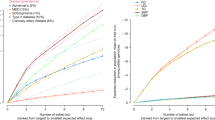Abstract
IN general, the calculation of maximum likelihood1,2 estimates of gene frequencies requires the preliminary calculation of trial values, followed by the computation of corrections to the trial values, by a method which is essentially Newton's method of successive approximations for getting a root of an equation. In many Pacific populations (Gilbertese, Fijians, etc.), only four or five Rh types CDe/C (R
1
R
1), CDe/c (R
1
r), CDE/c (R
1
R
2), cDE (R
2), and occasionally a little cDe (R
0) are present3, and the composition of the population can be explained by assuming that only three genes, R
1, R
2, and R
0, are present. For such cases the maximum likelihood equations can be solved explicitly, and the best estimates of the gene frequencies obtained without any process of successive approximations. If we designate the frequencies of the five phenotypes, in the order just mentioned, as H̄ K̄ P̄ T̄ and Q̄, the solution of the maximum likelihood equations gives the following formulæ: 
This is a preview of subscription content, access via your institution
Access options
Subscribe to this journal
Receive 51 print issues and online access
$199.00 per year
only $3.90 per issue
Buy this article
- Purchase on SpringerLink
- Instant access to full article PDF
Prices may be subject to local taxes which are calculated during checkout
Similar content being viewed by others
References
Stevens, W. L., Ann. Eugenics, 8, 362 (1938).
Fisher, R. A., Ann. Eugenics, 13, 150 (1946).
Mourant, A. E., “The Distribution of the Human Blood Groups” (Blackwell, Oxford, 1954).
Mourant, A. E., loc. cit., p. 386.
Williams, E. J., Med. J. Australia, 1, 739 (1949).
Boyd, W. C., Science, 118, 756 (1953); Amer. J. Human Genet., 6, 1 (1954).
Author information
Authors and Affiliations
Rights and permissions
About this article
Cite this article
BOYD, W. Maximum Likelihood Calculation of Rh Gene Frequencies in Pacific Populations. Nature 176, 648 (1955). https://doi.org/10.1038/176648a0
Issue date:
DOI: https://doi.org/10.1038/176648a0



